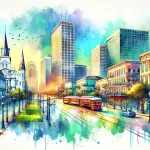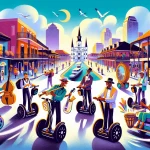New Orleans, a city brimming with a captivating blend of Native American, French, Spanish, and African influences, has cultivated a unique cultural identity. This extraordinary fusion has woven the city’s essence, transforming it into a melting pot of art, music, cuisine, and history.
In This Article
TL;DR
- New Orleans’ cultural roots stem from its multicultural heritage, intertwining Native American, French, Spanish, and African civilizations.
- Music, festivals, and culinary traditions lie at the core of the city’s cultural identity, with jazz being a significant global contribution.
- The vibrant arts scene, encompassing visual arts, literature, and performing arts, mirrors the rich cultural heritage and continues to evolve with modern innovations.
Historical Roots of New Orleans Culture
The cultural fabric of New Orleans is intricately woven with threads from various civilizations. Native American tribes, such as the Choctaw and Houma, originally inhabited the area. French and Spanish colonial rule, coupled with the introduction of enslaved Africans in the 18th century, further enriched the city’s cultural tapestry.
The Mississippi River played a pivotal role in shaping the economic and cultural life of New Orleans. The city’s strategic location transformed it into a hub for trade and commerce, attracting people from diverse backgrounds.
Music and Performing Arts
New Orleans is the birthplace of jazz, a musical genre that has left an indelible mark on the world. The city’s brass bands and legendary musicians, such as Louis Armstrong and Jelly Roll Morton, have made significant contributions to the evolution of jazz.
The current music scene in New Orleans is thriving, with numerous venues showcasing live performances. Preservation Hall, situated in the French Quarter, is a must-visit for jazz enthusiasts. The intimate setting allows visitors to experience authentic New Orleans jazz performed by talented local musicians. Shows run nightly from 5 pm to 10 pm, with tickets ranging from $15-$50 (323 St Peter St, New Orleans, LA 70116; (504) 522-2841).
Festivals and Celebrations
New Orleans is renowned as the festival capital of the world, with over 130 festivals taking place throughout the year. Mardi Gras, the most famous celebration, is deeply rooted in the city’s history and cultural significance. The festival, which takes place on the day before the start of the Christian liturgical season of Lent, features elaborate parades, colorful costumes, and lively music.
The New Orleans Jazz & Heritage Festival, commonly known as Jazz Fest, is another iconic event that showcases the city’s music, food, and crafts. The festival takes place annually over two weekends in late April and early May at the Fair Grounds Race Course (1751 Gentilly Blvd, New Orleans, LA 70119). Tickets start at $75 for a single-day pass.
Other notable festivals include the French Quarter Festival, which celebrates the city’s music, food, and architecture, and the Voodoo Music + Arts Experience, a multi-day event featuring an eclectic mix of musical genres.
Culinary Traditions
New Orleans’ culinary scene is a testament to its multicultural heritage, with Creole and Cajun cuisines taking center stage. Gumbo, a hearty stew made with a variety of meats, seafood, and vegetables, is a signature dish that reflects the city’s African, French, and Spanish influences. Another staple is jambalaya, a rice dish cooked with meat, seafood, and vegetables.
No visit to New Orleans is complete without indulging in beignets, square-shaped fried pastries dusted with powdered sugar. Café du Monde, a legendary coffee shop in the French Quarter, is famous for its beignets and café au lait (800 Decatur St, New Orleans, LA 70116; (504) 525-4544). The café is open 24/7, and a plate of three beignets costs $3.
Food markets, such as the French Market (1008 N Peters St, New Orleans, LA 70116), play a vital role in the city’s culinary traditions. The market, which dates back to 1791, offers a wide variety of local ingredients, prepared foods, and crafts. It is open daily from 9 am to 6 pm.
Visual Arts and Literature
New Orleans’ architecture, with its distinctive French and Spanish influences, has had a significant impact on the city’s visual arts. The French Quarter, known for its wrought-iron balconies and colorful buildings, has been a source of inspiration for countless artists.
The city has also been home to many notable authors and poets, such as Tennessee Williams, William Faulkner, and Anne Rice. The Tennessee Williams New Orleans Literary Festival, held annually in March, celebrates the playwright’s legacy and the city’s literary heritage.
Art galleries and events, such as the Julia Street Art Walk, which takes place on the first Saturday of every month, promote local artists and their work. The event features over 20 galleries in the Warehouse Arts District, offering visitors a chance to explore the city’s contemporary art scene.
Cultural Preservation and Education
Museums and cultural centers play a crucial role in preserving New Orleans’ heritage. The New Orleans Museum of Art (1 Collins Diboll Cir, New Orleans, LA 70124; (504) 658-4100), the oldest fine arts museum in the city, houses an extensive collection of French and American art, as well as African and Japanese works. The museum is open Tuesday through Sunday, with admission starting at $15 for adults.
Educational programs, such as those offered by the New Orleans Jazz National Historical Park (916 N Peters St, New Orleans, LA 70116; (504) 589-4841), promote the city’s arts and history. The park offers free ranger-led tours and live music performances, providing visitors with an in-depth understanding of jazz and its significance to the city.
Community initiatives, such as the Mardi Gras Indians, work to maintain cultural traditions. The Mardi Gras Indians, African Americans who create elaborate, hand-sewn costumes and parade through the streets during Mardi Gras and other festivals, have been a part of the city’s culture for over a century.
Modern Cultural Innovations
While New Orleans remains rooted in its rich history, the city’s culture continues to evolve. Contemporary music and arts movements, such as bounce music and street art, have emerged, adding new layers to the city’s cultural fabric.
Technology and modern media have also influenced traditional art forms. For example, the Preservation Hall Foundation has launched a series of online music education programs, making the city’s jazz heritage accessible to a global audience.
Emerging artists and cultural leaders, such as the Young Fellaz Brass Band and visual artist Brandan “BMike” Odums, are shaping the future of New Orleans’ culture. These young creatives are building upon the city’s traditions while infusing their own unique perspectives and experiences.
New Orleans’ culture is a vibrant, ever-evolving tapestry that reflects the city’s diverse history and the resilience of its people. From the streets of the French Quarter to the stages of Jazz Fest, the spirit of New Orleans continues to captivate and inspire visitors from around the world.






